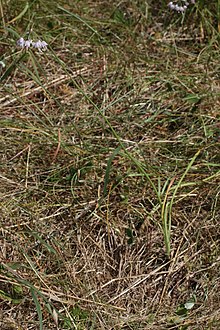Allium cernuum
| Nodding onion or lady's leek | |
|---|---|

| |
| A plant in bloom in Anacortes, Washington | |
| Scientific classification | |
| Kingdom: | Plantae |
| Clade: | Tracheophytes |
| Clade: | Angiosperms |
| Clade: | Monocots |
| Order: | Asparagales |
| Family: | Amaryllidaceae |
| Subfamily: | Allioideae |
| Genus: | Allium |
| Species: | A. cernuum
|
| Binomial name | |
| Allium cernuum | |
| Synonyms[1][2] | |
| |
Allium cernuum, known as nodding onion or lady's leek, is a perennial plant in the genus Allium. It grows in dry woods, rock outcroppings, and prairies. It has been reported from much of the United States, Canada and Mexico including in the Appalachian Mountains from Alabama to New York State, the Great Lakes Region, the Ohio and Tennessee River Valleys, the Ozarks of Arkansas and Missouri, and the Rocky and Cascade Mountains of the West, from Mexico to Washington. It has not been reported from California, Nevada, Florida, Louisiana, Mississippi, New Jersey, Delaware, New England, or much of the Great Plains. In Canada, it grows from Ontario to British Columbia.[3][4][5][6][7][8]
Description
Allium cernuum has an unsheathed slender conical bulb which gradually tapers directly into several keeled grass-like leaves (2–4 mm, 3⁄32–5⁄32 in wide).
Each mature bulb bears a single flowering stem, which terminates in a downward nodding umbel of white or rose flowers. Flowers appear in July or August. They are bell-shaped, about 5 mm (3⁄16 in) across, pink or white with yellow pollen and yellow anthers. This plant does not have bulblets in the inflorescence.
The flowers mature into spherical crested fruits which later split open to reveal the dark shiny seeds.[3][9][10][11][12][13][14][15]
Uses
Allium cernuum is edible and has a strong onion flavor, and has often been used in cooking. It is cultivated in many places for its attractive flowers.[16]
-
Seed head
-
Illustration from Britton and Brown 1913
-
Inflorescence
References
- ^ Tropicos
- ^ The Plant List
- ^ a b Flora of North America Editorial Committee (ed.). "Allium cernuum". Flora of North America North of Mexico (FNA). New York and Oxford: Oxford University Press – via eFloras.org, Missouri Botanical Garden, St. Louis, MO & Harvard University Herbaria, Cambridge, MA.
- ^ "Allium cernuum". County-level distribution map from the North American Plant Atlas (NAPA). Biota of North America Program (BONAP). 2014.
- ^ USDA, NRCS (n.d.). "Allium cernuum". The PLANTS Database (plants.usda.gov). Greensboro, North Carolina: National Plant Data Team.
- ^ IPNI Listing
- ^ Brako, L.; Rossman, A.Y.; Farr, D.F. (1995). Scientific and Common Names of 7,000 Vascular Plants in the United States. pp. 1–294.
- ^ CONABIO. 2009. Catálogo taxonómico de especies de México. 1. In Capital Nat. México. CONABIO, Mexico City.
- ^ Hilty, John (2016). "Nodding Onion (Allium cernuum)". Illinois Wildflowers.
- ^ Roth, Albrecht Wilhelm (1798). Archiv für die Botanik. 1 (3): 40.
{{cite journal}}: Missing or empty|title=(help) - ^ Gleason, H. A.; Cronquist, A.J. (1991). Manual of the Vascular Plants of Northeastern United States and Adjacent Canada (2 ed.). Bronx: New York Botanical Garden. pp. i–910.
- ^ Cronquist, A.J.; Holmgren, A. H.; Holmgren, N. H.; Reveal, J. L. (1977). "Vascular Plants of the Intermountain West, U.S.A.". In Cronquist, A.J.; Holmgren, A. H.; Holmgren, N. H.; Reveal, J. L.; Holmgren, P. K. (eds.). Intermountain Flora. Vol. 6. New York: Hafner Pub. Co. pp. 1–584.
- ^ Hitchcock, C. H.; Cronquist, A.J.; Ownbey, F. M.; Thompson, J. W. (1969). "Vascular Cryptogams, Gymnosperms, and Monocotyledons". In Hitchcock, C. L. (ed.). Vascular Plants of the Pacific Northwest. Vol. 1. Seattle: University of Washington Press. pp. 1–914.
- ^ Radford, A. E.; Ahles, H. E.; Bell, C. R. (1968). Manual of the Vascular Flora of the Carolinas. Chapel Hill: University of North Carolina Press. pp. i–lxi, 1–1183.
- ^ Moss, E. H. (1983). Flora of Alberta (2 ed.). Toronto: University of Toronto Press. pp. i–xii, 1–687.
- ^ Bailey, L.H.; Bailey, E.Z. (1976). Hortus Third. New York: MacMillan. pp. i–xiv, 1–1290.
External links
![]() Media related to Allium cernuum at Wikimedia Commons
Media related to Allium cernuum at Wikimedia Commons
![]() Data related to Allium cernuum at Wikispecies
Data related to Allium cernuum at Wikispecies



